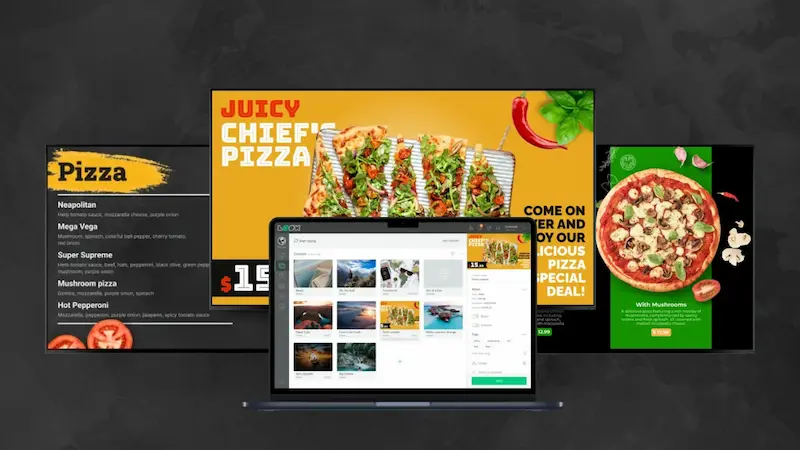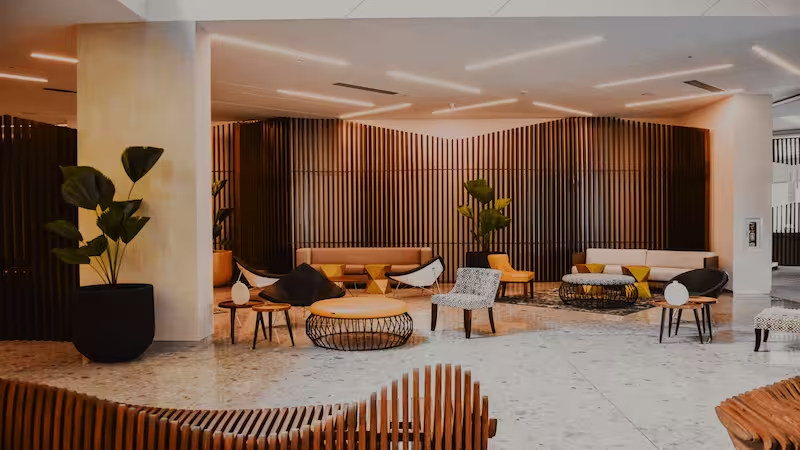
Table of Content
Introduction to Transparent Screens
Any electronic screen displaying information on a see-through surface is considered transparent. However, if you believe this is a novel technology, reconsider. Transparent technology has been around for a while, but it has only really come into the spotlight after the turn of the millennium. Around the conclusion of the first decade of the 21st century, there was a dramatic increase in the pace at which functional transparent displays were developed. In 2009 the first model was introduced into the market. These innovative displays, such as OLED, LCD, and LED, have revolutionized visual experiences by providing captivating, see-through surfaces. This piece will delve into the marvels of transparent screens, exploring their workings, applications, and the boundless possibilities they hold for the future of digital signage.
What Are Transparent Screens?
Transparent screens allow viewers to see through the screen, making the content visible on both sides. This technology can be used in various applications like retail displays, augmented reality, and interactive exhibits. These screens offer a futuristic, see-through effect, enhancing user experiences and blending digital and physical environments.
The Growing Popularity of Transparent Screens
According to Persistence Market Research, the market for transparent displays is expected to grow to $23.2 billion by 2033. The market is expected to expand at a CAGR of 29% from 2023 to 2033. The use of see-through screens has grown in recent years. Several sectors stand to benefit greatly from this technology, and it might also be used in other ways.
Types of Transparent Screens
Transparent screens are cutting-edge display technologies that offer see-through capabilities. Here are the types of transparent screens:
OLED Transparent Screens
OLED refers to an Organic Light Emitting Diode. This cutting-edge innovation finally makes transparent display materials a reality. In addition, it lets light through the screen while maintaining visibility. It means that transparent OLEDs can be used to make touch screens. As a result, the interaction feels more natural and interesting to the user.
LED Transparent Screens
Light-emitting diodes (LEDs) are a display technology used to create a picture on a transparent LED screen. The LEDs light is projected onto a see-through screen. Also, the screen's transparency makes it possible to see through it from either side. Interactive displays benefit greatly from transparent LED screens. They leave an indelible mark on whatever audience they encounter. These displays save power too, which is a nice bonus and an appealing option for commercial enterprises.
LCD Transparent Screens
A transparent LCD is a variant of the liquid crystal display technology. It allows light to flow through while still displaying a picture to the viewer. Furthermore, they may be used for everything from marketing to medical imaging. In addition, the glass's transparency makes for a novel medium for presenting information.
Features and Benefits of Transparent Screens
Transparent screens are a great choice for public installations. The following are some of the features and advantages of these screens:
High Transparency and Visibility
Transparent LED displays improve both clarity and field of view. Getting people to pay attention to what you're displaying is a breeze. Better picture quality may also be seen in transparent LED displays. Image contrast and clarity are improved as a result.
Interactive Capabilities
Transparent screens offer interactive capabilities, allowing users to engage directly with digital content while still seeing the physical world behind the display. This feature enhances user experience in various settings, such as retail, museums, and education, enabling interactive presentations, augmented reality experiences, and immersive product showcases.

Space-saving and Aesthetically Pleasing
Transparent screens offer space-saving and aesthetic appeal. By serving as both a display and a see-through surface, they eliminate the need for separate monitors, saving valuable space. Additionally, these screens blend harmoniously with the surroundings, creating a modern and visually pleasing environment for users and onlookers alike.
Industries and Use Cases for Transparent Screens
There are several situations when a transparent screen would be ideal. The following are a few examples of their potential applications:
Retail Sector Applications
Transparent displays provide striking visuals. They work well for displaying goods in shops and malls. These displays allow the retail industry to design a compelling customer journey. They do this by integrating images with tangible objects. An excellent example is when Samsung launched its new mirror and transparent OLED displays. The campaign aimed to show that these displays can do wonders for retail and advertising. Samsung pointed out that the OLED technology would offer better contrast and viewing angles.
Hospitality and Entertainment Uses
Entertainment venues sometimes employ see-through screens. These displays are a great way for bars, restaurants, and even small shops like nail salons to promote their products and services to the public. They make attracting new customers and increasing your company's profile simple. An excellent example is the modern fast-food chain Easta in San Francisco. Their technology-driven system streamlines the ordering and pick-up procedures, eliminating the need for any staff intervention. Patrons can conveniently use a mobile app to place their food orders, and iPads are also available within the restaurant for this purpose. Once the orders are confirmed, customers wait by a wall adorned with transparent LCDs, and a digital screen notifies them of their order status and the designated box number for their food delivery.
Transparent Screens for Hotel Check-in and Concierge Services
In hospitality, transparent screens are utilized for hotel check-in and concierge services. These screens serve as interactive displays, seamlessly blending with the hotel's interior design. Guests can check in or access concierge services by interacting directly with the transparent screen, providing a modern and efficient user experience. The transparency adds a touch of sophistication to the hotel's ambiance while maintaining functionality for smooth and convenient guest interactions.
Transparent Displays in Museums and Exhibitions
In museums and exhibitions, transparent displays offer an innovative way to engage visitors. These screens allow valuable artifacts to be showcased while incorporating interactive digital content seamlessly. The transparency feature enhances the viewing experience, as visitors can simultaneously observe physical exhibits and digital overlays. This technology transforms static displays into immersive and educational experiences, enabling museums to captivate audiences with a blend of historical objects and modern storytelling techniques.
A good example is how a transparent OLED illuminated the Guggenheim's annual Young Collectors Council party. At this party, the Guggenheim and LG launched a five-year, multidimensional relationship to study, reward, and promote artists who use technology as a medium. LG Display, a pioneer in transparent OLED technology, showcased its latest and greatest creations to visitors.

Transparent Screens in Automotive Industry
Transparent displays are commonplace in showrooms that sell electronics and automobiles. Customers can get a good look at a car, for instance, without getting too near; hence they are often used behind glass. Transparency is key when you want people to admire your vehicles without touching them or getting too near. It is why showrooms employ transparent screens; they enable people to view displays while shielding them from dirt and harm. For instance, an excellent campaign was the Transparent OLED Auto Showroom at ISE 2019. The idea was to make purchasing cars more enjoyable using transparent OLED technology.

Transparent Screens in Healthcare
Transparent displays in healthcare offer innovative use cases, transforming the industry. Doctors can maintain direct eye contact with patients while accessing crucial information in real time by overlaying medical data, patient vitals, and diagnostic images on transparent screens. It enhances patient-doctor interactions, improves diagnosis accuracy, and streamlines medical workflows. For example, transparent screens are being utilized in operating rooms to assist surgeons during procedures. These screens can display patient data, medical images (like X-rays, CT scans, and MRI), and virtual overlays that help guide surgeons during surgery, improving precision and safety.
Factors to Consider When Choosing Transparent Screens
There are many factors to consider when deciding on a transparent display for a certain application. Here are some things to keep in mind when selecting a see-through display.
Transparency Levels and Brightness
The screen's performance is affected by the quantity of light that flows through it, which is determined by its transparency level. Greater transparency results in better visibility, light, and true colors. A greater transparency rate may also aid in lowering energy needs. Since more light is let through, less power is required to power the display.
When choosing a see-through screen, brightness is another crucial factor. Certain applications need a lot of brightness to be legible in sunny or brightly lit environments. The screen's brightness in direct sunlight is only one of several variables that affect its luminosity. Screens used in a semi-outdoor setting need higher brightness levels during the day and lower levels at night. The same holds for artificial lighting used indoors. Clear displays may provide anything from 1,000 to 6,000 nits of brightness. Indoor displays typically only need 500-2,000 nits of brightness. Semi-outdoor displays offer a brightness of 4,000 to 6,000 nits. Screens that are too bright inside might cause eye strain. So, it leaves a bad impression.
Interactive Touch Technology
Interactive touch technology is a crucial factor to consider when selecting transparent screens. It lets users interact directly with the display, allowing intuitive navigation, content manipulation, and engaging experiences. This technology enhances usability and functionality, making it essential for a seamless, transparent screen solution.
Integration and Installation Flexibility
When choosing a transparent screen, consider the ease of setup and configuration. High-quality transparent displays will offer straightforward assembly instructions and a sturdy build to reduce installation time and effort. In addition, displays with low repair and maintenance costs have less downtime.
Popular Transparent Screen Brands and Manufacturers
Discover the cutting-edge world of transparent screens with some popular brands and manufacturers. From innovative technology to sleek designs, explore the forefront of display advancements with the following options.
LG: Features and Offerings
LG transparent screens offer cutting-edge display technology that seamlessly integrates into various environments. These screens provide stunning, transparent visuals, allowing users to see objects behind the display. With high-definition resolution and advanced image quality, LG transparent screens are perfect for advertising, retail, and architectural installations. They offer interactive capabilities, enabling engaging experiences for users. These futuristic screens redefine visual communication, making them ideal for businesses seeking innovative, eye-catching display solutions. A good example is the 55" FHD Transparent OLED Touch.

Leyard: Innovations and Product Range
The Leyard Transparent OLED Displays use state-of-the-art OLED technology to allow for fully see-through installations with a nearly frameless glass design. In addition to providing all the advantages of interactive digital signage, the glass's 38% light transmittance lets customers view the product or sceneries behind the display. Retail, corporate displays, museum exhibitions, award or trophy cases in educational or business settings, trade show exhibits, and a wide variety of other architectural applications are perfect for Leyard Transparent OLED Displays. A worthy example is the Planar® LookThru™ Transparent OLED Display.
Optimize your business with transparent screens
Because of their adaptability, transparent displays are gaining popularity and improving any room's overall beauty. Furthermore, they are aesthetically pleasing, have efficient energy use, and are durable. They also provide more content flexibility and freedom than conventional screens. Your customers will gain a better experience thanks to these displays.








